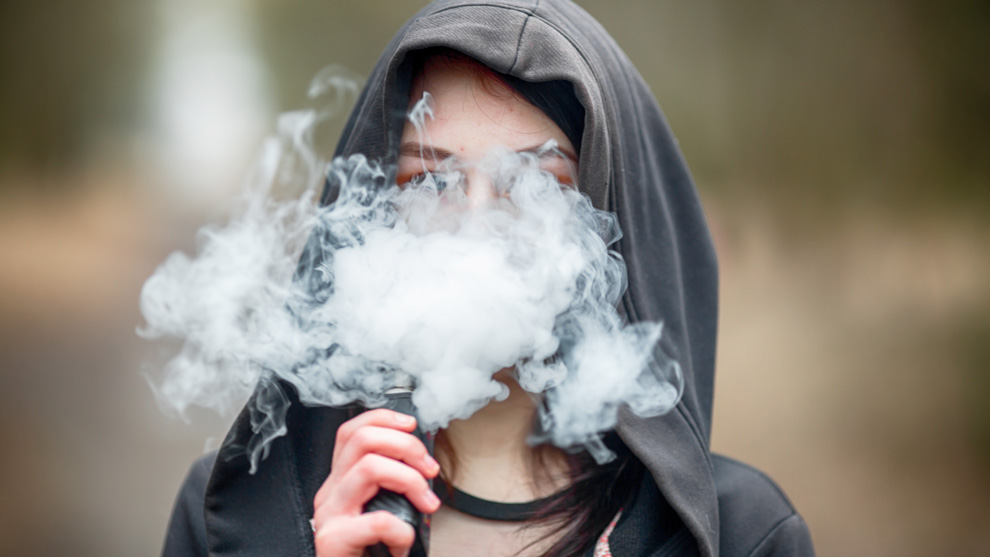Se ve como una opción saludable al tabaco, incluso como una solución para dejar de fumar, pero no hay evidencia científica, afirma especialista universitaria

os vapeadores, cigarros electrónicos e híbridos son mucho más dañinos que los convencionales; además, las afectaciones se presentan de forma aguda, es decir, pueden aparecer al siguiente día de utilizarlos y son muy aparatosas, “te llevan al hospital”, señala Guadalupe Ponciano Rodríguez, directora del Programa de Investigación y Prevención del Tabaquismo de la Facultad de Medicina.
Esos dispositivos que se han puesto de moda, más entre los jóvenes y adolescentes, funcionan por medio de una batería o conectados a la corriente para calentar y vaporizar una solución líquida que se inhala y que puede ser muy dañina, pues no es agua, sino una combinación de componentes químicos, como el propilenglicol, el etilenglicol y la glicerina; a éstos se les conoce como sistemas electrónicos de administración de nicotina, o SEAN.
Desde que aparecieron, se vendieron como una opción saludable al cigarro, e incluso como una solución para dejar de fumar; sin embargo, no hay evidencia científica que apoye estas afirmaciones. “Se ha comparado con terapias de reemplazo de nicotina, como los parches por ejemplo, que se compran en la farmacia, y que sí dan resultado. Hay grupos provapeo, muchos pagados por la industria tabacalera, y argumentan una supuesta inocuidad de estos productos; hay mucha gente que se confunde, pero la realidad es que son muy dañinos a la salud”, apunta .
Ponciano Rodríguez comenta que “estos dispositivos nos preocupan mucho por la alta cantidad de nicotina. En un cigarro tradicional hay cerca de un miligramo de nicotina por pieza; los pods o cápsulas de esos implementos que usan tabaco laminado pueden llegar a tener hasta 60 miligramos; es como si fumaras 60 cigarros de una vez. Hemos visto que la nicotina actúa a nivel del músculo cardiaco, venas y arterias por lo que puede agravar padecimientos como la aterosclerosis”.
El mercado más común
Es importante aclarar que los líquidos que se emplean en los SEAN, que tienen colores muy llamativos, no son agua, sino combinaciones de componentes químicos muy tóxicos, “los saborizantes que se utilizan para que se aprecie menos el sabor del tabaco y sepa a durazno, mango, u otros sabores exóticos, hacen que los adolescentes no tengan una percepción adecuada del riesgo, y algunos colorantes por ejemplo los rojos, pueden llegar a producir cáncer, además que todo esto le llama mucho la atención a los jóvenes, lo que los induce muy rápido a la adicción”.
Todas las drogas “ocasionan una dependencia física, es decir, que el organismo se acostumbra a los efectos que le produce su consumo, pues el fumador detecta una serie de síntomas generados al inhalar y su organismo se acostumbra al efecto estimulante, además que actúa en el nivel de recompensa del cerebro, por lo que hace sentir mejor al individuo sin importar la situación en la que se encuentre”, dice Guadalupe Ponciano.
También hay dependencia psicológica, en la que el individuo que hace uso de esta droga tiene pensamientos alrededor de ella, por ejemplo, que los ayuda a concentrarse o a desinhibirse, a sentirse más guapos o a divertirse, “y cuando se juntan la dependencia física y la psicológica, tu cuerpo lo pide y tú lo necesitas para realizar tus actividades”, asegura la experta.
Otro daño muy importante se da cuando se le agregan elementos oleosos a estos vaporizadores, como aceite de Cannabis, vitaminas A o E, porque el cuerpo no tiene ningún mecanismo de defensa para expulsar las microgotas aceitosas que entran al tracto respiratorio, lo que ocasiona un tipo muy particular de neumonía grasa que se queda atrapada en los alveolos, bronquiolos y bronquios.
Además de las afectaciones al sistema respiratorio, se han reportado muchos casos de explosión de la batería que se utiliza para calentar el tabaco, lo que ha resultado en pérdida de falanges, e incluso de fractura de mandíbula.
La recomendación
“El llamado es a que se informen –insiste Ponciano Rodríguez– que sepan la realidad sobre el daño que causan estos dispositivos, y que no lo hagan; su praxis se ha normalizado y muchos jóvenes inician en el tabaquismo por el cigarro electrónico. Es una práctica reciente y no hemos visto los daños a largo plazo aún, los híbridos salieron hace unos dos años. Es importante aprender del pasado: con el tabaco nos costó mucho tiempo comprender las afectaciones que ocasiona. Si sabemos que causan daño, no tiene caso esperarse a que pasen 20 años para ver las consecuencias, porque implica que mueran muchas personas”, termina la especialista.



